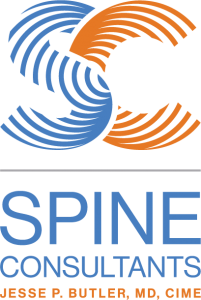Hunching beyond the normal range of your back may cause you to experience some back pain. The symptoms of kyphosis, however, may be more severe, such as pain and reduced mobility. Certain types of kyphosis may require different treatments, including possible surgical procedures.
What Is Kyphosis?
Kyphosis is an abnormally rounded upper back or hunchback. There are three main types of problematic kyphosis.
Postural kyphosis
While the spine should follow its natural curve rather than staying perfectly straight, slouching too much can worsen the spin. Postural kyphosis is a hunched back due to poor posture and is more common in adolescents. This condition typically happens in adolescence with teenage girls developing this more than teenage boys.
Scheuermann’s kyphsosis
Scheuermann’s kyphosis occurs when the front of the vertebrae doesn’t grow as fast as the back, causing the bones to form a wedge shape. Scheuermann’s kyphosis can be more severe than postural kyphosis, as it also affects the lumbar spine. Boys are more likely to have it than girls, and it stops progressing when teens reach adulthood.
Congenital kyphosis
Congenital kyphosis is the rarest form of kyphosis, being diagnosed at birth. It results from defects occurring during fetal development. Congenital kyphosis is characterized by vertebrae that fuse together rather than separate normally.
Causes of Kyphosis
The development of kyphosis may have a genetic basis. Our bodies become weaker with age, making us more susceptible to injury and disease as we get older, which can lead to spinal deformities and eventually kyphosis. Some disorders that could also put you at a greater risk of developing this condition include:
Compression fractures: Kyphosis occurs when the vertebrae fall toward each other due to a compression injury. Osteoporosis causes bones to become thin and weak, leading to compression fractures.
Degenerative spinal arthritis: This type of arthritis can worsen over time and cause stiffness.
Ankylosing spondylitis: An inflammatory form of arthritis, it commonly affects young adults.
Muscular dystrophy: This genetic condition weakens muscles, including those around the spine.
Spinal tumor: Any type of spinal tumor can compress and affect your flexibility, resulting in a hunched-forward posture.
Symptoms of Kyphosis
Kyphosis may cause bending forward of the head, a rounded back, or pain in the upper back. The more severe the curve, the more severe the symptoms, including:
- The back and shoulder blades feeling painful or stiff
- Weak and tingling legs
- Extreme exhaustion
- Breathing difficulties or shortness of breath due to the spine pressing on the airways
- Poor balance
- Urinary incontinence
Diagnosis of Kyphosis
Your doctor will consider your medical history, especially any conditions that might have caused kyphosis, such as osteoporosis. Your doctor may ask you what symptoms you’re experiencing and how they affect you.
When you have a serious curvature, your doctor might perform a pulmonary function test to ensure that your lungs are functioning properly. You might also suffer spinal cord compression when you have a severe curve. You may need an MRI to confirm the diagnosis of kyphosis.
An MRI uses a magnetic field and radio waves to create detailed pictures of your spine. This test can also help determine whether the curve is flexible or rigid.
Spine surgery may be used to correct the spinal curve and stabilize the spine if a severe case of kyphosis is affecting breathing or neurological function. This type of procedure is usually prescribed only if more conservative methods have been unsuccessful. Other treatment options include:
Treatments for Kyphosis
If you have postural kyphosis, the doctor may recommend nonsurgical treatments. If Scheuermann’s kyphosis is less than 75 degrees, nonsurgical options are also available.
Kyphosis can be treated in several ways, including:
Physical therapy
Physical therapists will guide you through exercises that may strengthen your back muscles, improve posture, and relieve your pain. You may do PT alone or with a trainer.
Bracing
Braces are effective at maintaining proper posture or correcting curvature while the patient uses other treatments such as physical therapy and certain types of medication.
Anti-inflammatory Medication
A doctor may prescribe nonsteroidal anti-inflammatory medications to help relieve pain caused by kyphosis. When used for a short amount of time, NSAIDs are commonly safe and effective.
Surgery
If kyphosis causes severe pain and other symptoms, surgical treatment is an option. People with congenital kyphosis and Scheuermann’s kyphosis who have a curve greater than 75 degrees may require spine surgery.
Surgical treatment for kyphosis typically relies on spinal fusion. A surgeon uses small pieces of bone to fill the spaces between the vertebrae to align the vertebrae into a straight position and then bonds them together to fuse. This procedure helps reduce the severity of the curve, preventing further deterioration and stabilizing the body.
Make Sure to Get Kyphosis Diagnosed Early
Early diagnosis is key to treating kyphosis since people with kyphosis who get diagnosed early rarely require surgery. Even after treatment, kyphosis may return so it is important to take steps to stay strong to prevent its return. If you believe you have kyphosis, the best thing you can do it to see an othropaedic spine doctor, who can diagnose your condition and give you recommendations on steps to take.

